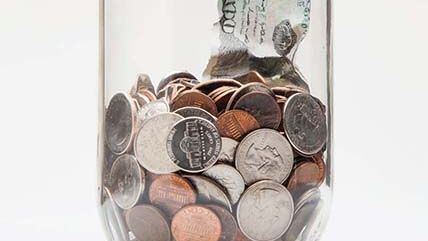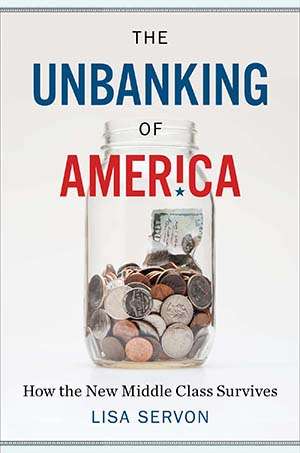Why Customers Like Check Cashers and Payday Lenders
Many Americans prefer alternatives to traditional banking.

The Unbanking of America: How the New Middle Class Survives, by Lisa Servon, Houghton Mifflin Harcourt, 272 pages, $27

"My parents opened my first savings account for me when I was seven," Lisa Servon writes at the beginning of The Unbanking of America: How the New Middle Class Survives. "The teller gave me a green Pulaski [Savings and Loan] passbook with gold lettering. It made me feel important, like I'd crossed some threshold and joined a club that bigger kids and grownups got to be a part of."
Clearly nostalgic for her rite of passage, Servon, a professor of city and regional planning at the University of Pennsylvania, sets out to discover why that experience has become alien to so many modern Americans, and what practices and services they've adopted to replace banks in meeting their financial needs. She speaks with experts, entrepreneurs, and people trying to make ends meet, and she even takes jobs at a check-cashing store and a payday loan business. She concludes that banks as currently constituted aren't a good choice for everybody, and that many alternatives—including some options widely reviled by pundits and politicians—do a better job of serving many people's needs.
The numbers of Americans who either don't have bank accounts (the "unbanked") or use them sparingly alongside alternative financial services (the "underbanked") can be startling if you were raised on bank robber Willie Sutton's apparently apocryphal wisdom that "that's where the money is." "As of 2013, the year of the [Federal Deposit Insurance Corporation's] most recent survey, approximately 8 percent of Americans were unbanked and another 20 percent were underbanked," notes Servon.
The 2015 survey, released after her book was written, finds nearly identical numbers, but alienation from the banking system is even more remarkable in some major communities. In 2015, the Albuquerque Journal found that 11 percent of area households had no bank accounts, while 24.4 percent kept one account while also using alternative services. Likewise, in 2015 The Kansas City Star reported that 12 percent of local households—and 45 percent of local African-American families—completely avoided banks.
Why do so many Americans shun the institutions traditionally devoted to saving and loaning money? The answer, many people tell Servon, is that banks don't seem to want their business and make it too difficult and expensive to get anything done.
"Banks want one customer with a million dollars," the owner of one check-cashing chain tells her. "Check cashers like us want a million customers with one dollar."
The check-cashing magnate has a clear interest in portraying his business in a populist way, especially given the criticism his industry faces from such politicians as Sen. Elizabeth Warren (D–Mass.) and such activist organizations as the Public Interest Research Group. But as Servon learns, people who use such services seem to agree with that description. Check cashers and payday lenders may charge seemingly high fees, but they're knowable fees.
"Customers can find it difficult to predict when banks will charge them a fee (they sometimes change the timing) and what the amount of the fee will be; this lack of clarity can be costly," Servon writes. "Now imagine the interior of a check casher—or visit one. It resembles a fast food restaurant more than a bank. Posters tell you what products are sold, and large signs above the teller windows list every product, along with its price."
Alternative services come with clear costs—and they move fast. Somebody facing bills needs a paycheck cashed now, not after an arbitrary delay while the check clears. Unpaid rent or unpurchased groceries are bigger concerns than a few dollars in fees.
Also, those fees aren't necessarily so high when you consider the available options. When concerned Oregon lawmakers restricted "expensive" payday loans in 2007, borrowers shifted to comparable products offered by banks. "It's called an overdraft," Servon reports, "and if it had a repayment period of seven days, the APR for a typical incident would be over 5,000 percent." The options in New York, where payday loans are entirely illegal, are even more stark. Servon interviews loan sharks who satisfy borrowers' needs entirely beyond the reach of regulators' conceptions of how markets should work.
In addition, Servon points out that an estimated 6 percent of Americans over the age of 15 participate in rotating savings and credit associations (ROSCAS)—a fancy name for clubs in which participants put money aside and make lump sums available to start businesses and finance major purchases. Based in traditional cultural practices from around the world, such clubs are governed by mutually agreeable rules and are unmonitored except by the communities in which they operate. ROSCAS meet needs that established banks can't or won't satisfy in an understandable way, especially (but not exclusively) for low-income immigrants.
Financially sophisticated young Americans are also turning away from traditional banking. Peer-to-peer lending through online services such as Prosper and Lending Club "requires far less paperwork than other loans and is perceived to be more transparent than payday loans," writes Servon. Loans through these platforms tend to be relatively inexpensive, too. Online-only banks such as Simple and Walmart's GoBank cater to customers seeking greater transparency and lower costs, and some offer financial advice that millennials in particular find helpful.
Servon's explanation for why banks are so opaque in their operations and unresponsive to consumer needs is a bit self-contradictory. On one hand, she attributes the disconnect to greed and lack of oversight. "The spirit of deregulation explains the massive move away from policy that protected consumers and smaller banks, launching the Wild West attitude that gained momentum over the next two decades," she claims. She also laments the loss of a supposed old-timey sense of "public interest" and insists that modern banks have "focused so single-mindedly on profit that they've sacrificed the well-being of their customers."
But that's not the tale she hears from everybody.
"The regulators are causing the opposite of the desired effect by making it so dangerous now to serve a lower-income segment," JoAnn Barefoot tells the author. A former official with the U.S. Department of Housing and Urban Development, the Federal Housing Administration, and the Federal Home Loan Bank Board, and a deputy controller of the currency, Barefoot points to a web of red tape—much of it intended to battle discrimination—that makes serving many potential customers a legal minefield.
The Albuquerque Journal report on the unbanked also noted that "regulations stemming from the Dodd-Frank Wall Street Reform and Consumer Protection Act of 2010 and the Patriot Act of 2001 have created an almost adversarial credit environment for people whose finances are in cash."
Traditional banks have meanwhile gained a reputation for working hand-in-hand with government. That relationship certainly doesn't serve the needs of the many customers, from illegal immigrants to established businesses, who want to avoid official scrutiny of their transactions. When Servon asks a successful building contractor why he uses check-cashing services, he answers, "The insurance, the taxes, the workers comp—it's killing us. Some guys try to hide as much of their income as they can—they got two-million-dollar businesses and they report half a mil. I'm telling you—it's impossible to stay afloat if you don't do some of that."
And when banks try to offer what customers want, they get slapped by critics who disapprove of those products. "Some banks, like Wells Fargo, offered payroll-advance loans for a while," Servon notes. "But once the media reported that these loans were basically the same as payday loans, the banks stopped offering the products. The risk to their reputation was too great."
Not that banks aren't perfectly capable of making their own problems—as revelations over bogus accounts opened in people's names by Wells Fargo employees chasing sales goals demonstrate. But that scandal was only one of the more recent nails fastening the lid on the coffin of the banking industry's relationship to many Americans.
Servon favors a combination of new regulations, government-guided innovation, and perhaps the return of the U.S. Postal Service (USPS) to the retail banking role it abandoned in 1967. But she acknowledges that regulation may kill innovation, and that "it's unclear whether the USPS has the capacity to distribute financial services efficiently."
Some of the innovators she highlights clearly have that capacity, however—if they're allowed to serve their customers.
Whether through apathy or perverse regulatory pressure, banks seem to be withdrawing from serving low- and middle-income Americans. But the market hates a vacuum, and demand has a long history of drawing supply. At its best, The Unbanking of America is the fascinating story of how people work together to develop means, some old and some new, of meeting Americans' financial needs.
This article originally appeared in print under the headline "Living Without Banks."


Show Comments (95)